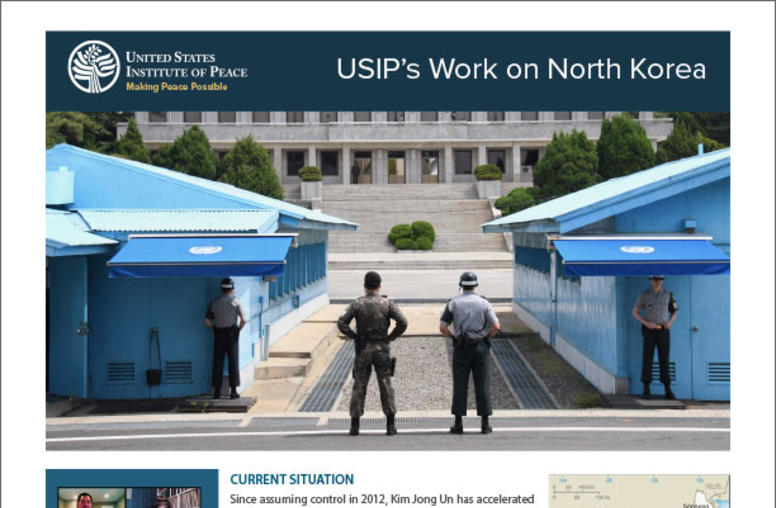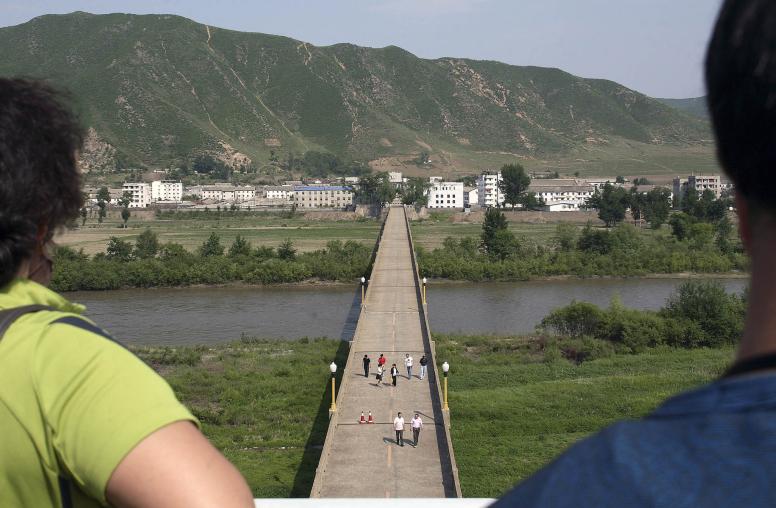Can Markets Help Foster Civil Society in North Korea?
By building social trust and sharing information, North Korean market actors are helping to lay foundation for civil society.
After North Korea’s planned economy faltered in the 1990’s, resulting in a devastating famine known as the “Arduous March,” citizens turned to an informal market system for survival. Desperate for some semblance of stability, the North Korean state initially tolerated these rudimentary transactions as a financial necessity. These markets have grown in scale and complexity over the last two decades—and in the process, have facilitated the growth of unofficial economic networks that exhibit signs of a nascent semi-autonomous public sphere that is unprecedented in North Korean society.

And while these market systems remain at the whims of an ambivalent and totalitarian regime, a new report is exploring the possibility that the strategies used by North Korean market actors—such as building social trust and sharing information—could help establish the building blocks of a North Korean civil society. “With these trust networks, market participation and strategies can turn into shared norms and idea,” said Andrew Yeo, co-author of the report and director of Asian studies at Catholic University.
This is not to say that civil society in North Korea exists currently or that market activity will lead to the development of civil society. “Most networks derived from markets remain private and small scale,” said Yeo at a USIP virtual event launching the report. “But market participation strategies … to some degree facilitate these social relations among the market participants.”
A Look at Markets in North Korea
While some official markets in North Korea exist, many are not formally recognized by the state. Operating without the regime’s official backing, market actors in North Korea experience a great deal of uncertainty. “Policies can shift at any time, the state can crackdown at any time,” said Justin Hastings, report co-author and professor of international relations and comparative politics at the University of Sydney. “The level of support, the level of hostility they [the regime] will have will vary over time.”
Currently, Kim Jong Un has attempted to recentralize power but has also allowed markets to continue—a departure from his predecessors’ sustained assault on market activity—in part because the profits generated by the market help sustain the North Korean state. “The North Korean regime is addicted to markets. They need the revenue generated by these market actors … marketization is necessary for the survival of the population,” said Hastings.
Despite the looming threat of the regime, the North Korean state has shown that it does not have complete control over the markets. “We often see these sort of state regulations of markets or macro activity following what happened in the market, not preceding,” said Hastings. “The state is chasing control rather than exercising it.”
This creates room for a semi-autonomous public sphere—one that, while subject to interventions by the state, is not entirely dominated or orchestrated by it. Even though its initial stages seem crude by modern standards, North Korean marketization has proven to be a powerful tool for facilitating connections between citizens.
But the regime’s reluctance to support broader economic reform in North Korea has left many market actors without access to basic enforcement mechanisms, such as contracts and third-party dispute resolution. This is intended to keep social trust low, as actors aren’t able to reliably interact with one another.
To overcome this, market actors are adopting strategies that reflect institutions found in civil society: use of trusted third-party intermediaries, patron-client networks, and the makings of public-private partnerships by which market actors leverage their relationships with state officials to decrease uncertainty. And while “all of this seems second nature” to those living in a capitalist society, Hastings said that these developments offer market actors a vision of interpersonal relationships not facilitated by the state.
What Do We Mean by Civil Society?
“Civil society is a frustratingly difficult concept,” said Yeo. “In its ideal form, it remains independent of states and markets. In reality, civil society often intersects with these two spheres.”
Contrary to some public representations, a formal “public” life exists in North Korea in the form of associations. Trade organizations and neighborhood watch-like groups are a part of everyday life for North Koreans. However, these groups are not just monitored by the state—they’re directly organized by it.
Civil society, on the contrary, operates independently. It is a place where citizens are able to act collectively in public to express interests, passion, and ideas; exchange information; or make demands on the state.
But amid North Korea’s infamously repressive regime, an emerging civil society might take a very different form. “I don't think we're going to see a liberal, Western, free-flowing bourgeois civil society public sphere” in North Korea, said Celeste Arrington, a Korea Foundation associate professor at George Washington University.
“This traditional view that places civil society actors in direct opposition to a theoretical state is probably not a useful exercise for the North Korea context,” said Jieun Baek, a fellow at Harvard’s Belfer Center for Science and International Affairs. Rather, she would expect a nascent civil society in North Korea to reflect those in China and Vietnam.
Public life in these nations is not necessarily free and open, but the structure of civil society there does play an important role in helping to coordinate and resolve issues. “You need something there when the government’s not,” said Yeo.
Markets popped up to address past failures by the North Korean government. Using similar strategies to create a civil society where communities are capable of collaborating based on mutual trust could offer the same benefit going forward: “The whole idea is to improve the lives of North Koreans … I'd say that people in China are much better off than they are in North Korea, that might be one way of looking at it,” said Hastings.
Parallels Between Market Activity and Civil Society
Since profit from North Korea’s markets are vital to the country’s and regime’s survival, the public space that they occupy has opened the door for the connective nature of market activity to lay the groundwork for a possible civil society.
And while the North Korean regime keeps a tight grip on public dissent, “The regime is unable to fully control daily life, or the flow of information within the country,” said Yeo. Citizens might not go as far as directly criticizing the regime, but they “might indirectly criticize the status quo by complaining about corrupt local officials or speculating on why economic ambitions have not improved.” Interactions such as this could offer the building blocks for social capital and the creation of new norms and networks.
Even further, ongoing and mutually beneficial interactions between market actors and between market actors and the state all facilitate a cooperative environment. Once that baseline of trust is established, these relationships can develop into networks that have allowed for things like credit to be established. “Even if they’re driven by profit and self-interest, rather than collective interest,” these sorts of interactions can mimic the functions of civil society, said Yeo.
Additionally, the semi-autonomous networks created by marketization offer the opportunity to establish shared norms regarding what behavior is acceptable and unacceptable—a key component of civil society, and an indicator that priorities have moved on to communal, rather than self, interest.
A Long Way to Go
Despite cautious optimism, North Korea is far from realizing a full civil society. Kim Jong Un and the North Korean regime do not face any immediate legitimacy crisis. Widespread public dissent—or deviation from state policy—is not likely with North Korea’s expansive surveillance programs. And with the COVID-19 pandemic, markets have suffered setbacks as the regime closed borders amid suspected economic and humanitarian crises.
Even marketization is not guaranteed to lead to civil society. While the strategies of market actors and civil society might mimic one another, they are not interchangeable—especially in North Korea, where markets developed as a means of survival for citizens. “Are they just so busy putting food on the table, that there's hardly any time to move the discussion beyond the transactions?” said Arrington.
However, there is evidence that the inklings of a civil society are alive and well in North Korea. Yeo pointed to defector accounts that reveal space for dissent, such as union leaders turning a blind eye to minor indiscretions.
Moreover, both Baek and Arrington pointed to often-hidden evidence of dissent, such as double-speak, jokes, and other forms of communication that indicate a tension between the lived realities of North Koreans and the narrative dictated by the state. “It's oftentimes through anecdotes and through testimonies, difficult to capture, perhaps impossible to capture accurately in a large survey, but these do exist,” said Baek.
For Yeo, the rise of a semi-autonomous public sphere and evidence of small-scale dissent “shows that North Koreans are not really passive recipients of state-approved ideas. Instead, they may reconcile the gap between their lived experience and the official state narrative by engaging in their own bottom-up discourse with others within their trust network.”



